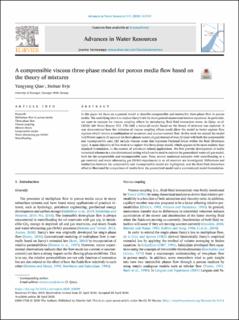| dc.contributor.author | Qiao, Yangyang | |
| dc.contributor.author | Evje, Steinar | |
| dc.date.accessioned | 2020-06-30T11:12:08Z | |
| dc.date.available | 2020-06-30T11:12:08Z | |
| dc.date.created | 2020-04-22T14:55:11Z | |
| dc.date.issued | 2020 | |
| dc.identifier.citation | Evje, S., Qiao, Y. (2020) A compressible viscous three-phase model for porous media flow based on the theory of mixtures. Advances in Water Resources, 141 | en_US |
| dc.identifier.issn | 0309-1708 | |
| dc.identifier.uri | https://hdl.handle.net/11250/2660061 | |
| dc.description.abstract | In this paper we focus on a general model to describe compressible and immiscible three-phase flow in porous media. The underlying idea is to replace Darcy’s law by more general momentum balance equations. In particular, we want to account for viscous coupling effects by introducing fluid-fluid interaction terms. In [Qiao, et al. (2018) Adv Water Resour 112: 170–188] a water-oil model based on the theory of mixtures was explored. It was demonstrated how the inclusion of viscous coupling effects could allow the model to better capture flow regimes which involve a combination of co-current and counter-current flow. In this work we extend the model in different aspects: (i) account for three phases (water,oil,gas) instead of two; (ii) deal with both the compressible and incompressible case; (iii) include viscous terms that represent frictional forces within the fluid (Brinkman type). A main objective of this work is to explore this three-phase model, which appears to be more realistic than standard formulation, in the context of petroleum related applications. We first provide development of stable numerical schemes in a one-dimensional setting which can be used to explore the generalized water-oil-gas model, both for the compressible and incompressible case. Then, several numerical examples with waterflooding in a gas reservoir and water alternating gas (WAG) experiments in an oil reservoir are investigated. Differences and similarities between the compressible and incompressible model are highlighted, and the fluid-fluid interaction effect is illustrated by comparison of results from the generalized model and a conventional model formulation. | en_US |
| dc.language.iso | eng | en_US |
| dc.publisher | Elsevier Ltd. | en_US |
| dc.rights | Navngivelse 4.0 Internasjonal | * |
| dc.rights.uri | http://creativecommons.org/licenses/by/4.0/deed.no | * |
| dc.subject | hydrology | en_US |
| dc.subject | hydrologi | en_US |
| dc.title | A compressible viscous three-phase model for porous media flow based on the theory of mixtures | en_US |
| dc.type | Peer reviewed | en_US |
| dc.type | Journal article | en_US |
| dc.description.version | publishedVersion | en_US |
| dc.rights.holder | © 2020 The Authors | en_US |
| dc.source.volume | 141 | en_US |
| dc.source.journal | Advances in Water Resources | en_US |
| dc.identifier.doi | 10.1016/j.advwatres.2020.103599 | |
| dc.identifier.cristin | 1807535 | |
| cristin.ispublished | true | |
| cristin.fulltext | original | |
| cristin.qualitycode | 1 | |

